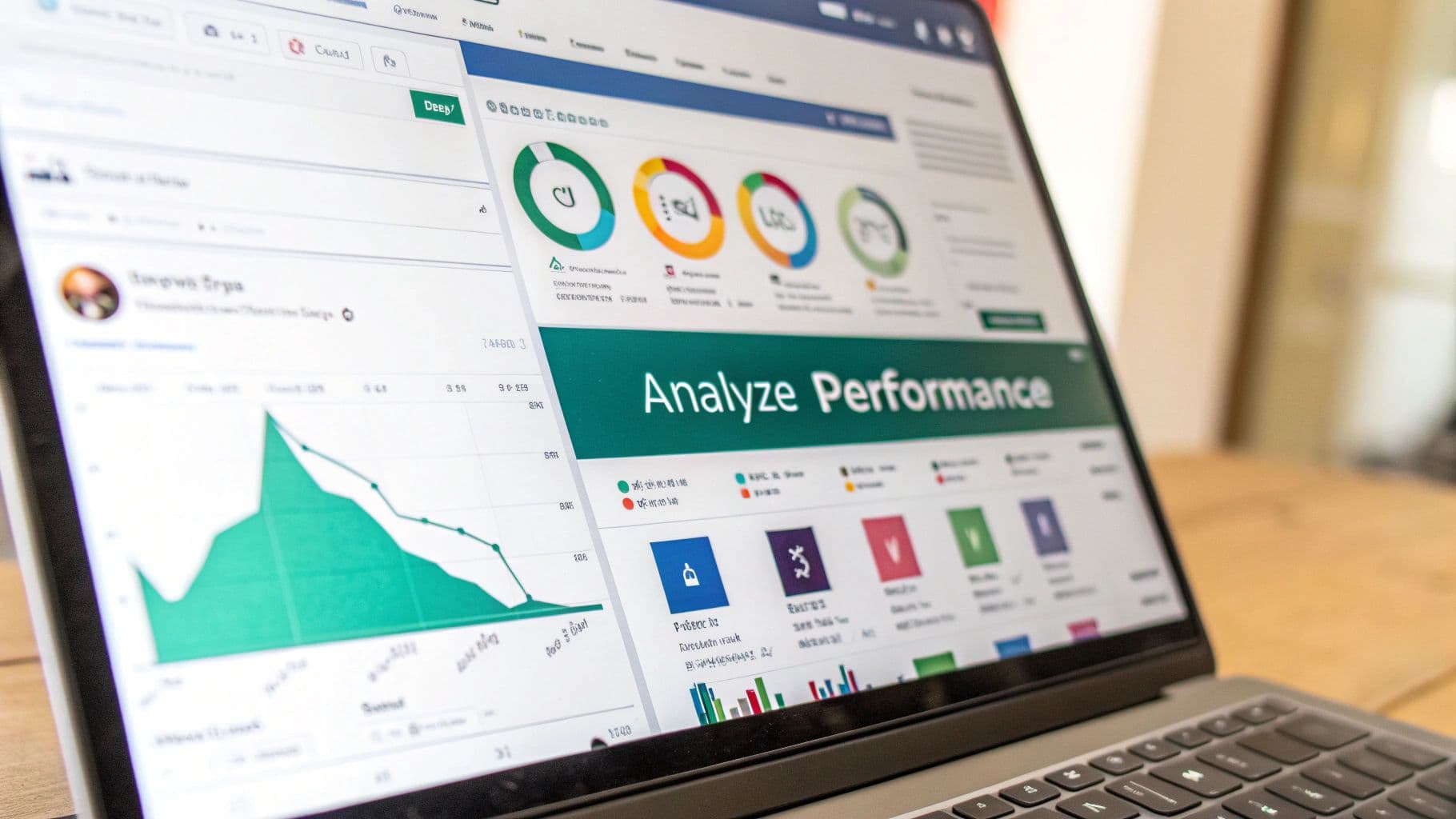Understanding Social Media ROI Fundamentals
Defining Social Media ROI
Think of social media ROI as the total value you get back from what you put into your social media efforts. This includes both direct financial returns and less tangible benefits. For instance, a Facebook campaign might not immediately drive sales, but could significantly boost your website traffic and brand recognition over time.
The Importance of Goal Alignment
For ROI measurement to work, your social media goals must match your broader business aims. Start by clearly defining what you want to achieve - whether that's more website visitors, new leads, or stronger brand awareness. Make your goals Specific, Measurable, Achievable, Relevant, and Time-bound (SMART) so you can track real progress.
Calculating Social Media ROI
To figure out your social media ROI, follow a simple yet essential process. First, set clear goals that connect to your business priorities. Then use this basic formula: ROI = ((Value from social media – Cost of social media) / Cost) * 100.
Here's a real example: Say an online store spends $18,000 total ($10,000 on ads, $5,000 on content, $3,000 on tools) and generates $50,000 in sales from social media. Their ROI would be 178%. Want to learn more about ROI calculations? Check out Hootsuite's guide to social media ROI.
Key Metrics to Track
Focus on these essential metrics to measure your social media success:
Reach: How many unique users see your posts
Engagement: Likes, comments, shares, and other interactions
Website Traffic: Number of social media visitors to your site
Leads: Potential customers coming from social platforms
Conversions: People who take desired actions like making purchases
By tracking these key numbers, you'll better understand what's working and make smarter decisions about your social media strategy. This sets you up for the more advanced measurement approaches we'll cover next.
Building Measurement Frameworks That Work

Let's explore how to create practical frameworks for measuring social media success. A solid measurement system helps you capture meaningful data and show the real value of your social media work.
Selecting the Right Metrics
The key to accurate measurement starts with picking meaningful metrics. While vanity metrics like follower counts look impressive, they often don't show true business impact. Instead, focus on metrics that connect directly to your goals. For example, if you're aiming for leads, track conversion rates and cost per lead. This helps ensure you're gathering useful data.
Implementing Effective Tracking Systems
Good tracking systems form the foundation of measurement. Set up UTM parameters to see exactly which social posts drive website visits. Connect your social data to your CRM (Customer Relationship Management) platform to understand how social engagement leads to sales. This gives you a clear picture of how social media impacts your bottom line.
Building Insightful Dashboards
Clear data visualization helps everyone understand your social media results. Create dashboards showing key metrics like conversion rates over time and cost per conversion across different campaigns. Simple, focused dashboards make it easy to spot trends and share wins with stakeholders.
Real-World Examples of Successful Measurement
Many companies effectively track social media's business impact. Online stores can follow customers from the first social click through the final purchase. B2B firms measure how social media brings in leads and builds their sales pipeline. These examples show how customized measurement helps prove social media's value.
According to recent studies, 96% of marketers believe social media delivers positive returns, yet 83% struggle to choose the right metrics. This highlights why having clear analytics and metrics matters. Find more statistics here. Read also: How to master business growth.
Connecting Social Media to Business Outcomes
The key to measuring social ROI is linking social activities to real business results. Focus on how social media affects your entire customer journey, not just engagement numbers. When you track metrics tied to revenue and growth, you can show social media's true value and make smarter decisions about your strategy.
Setting Strategic Goals That Drive Real Results

Good social media measurement requires moving beyond just collecting data. This section explores how to set goals that meaningfully impact your business performance. We'll look at creating objectives that drive real results instead of vanity metrics.
The Power of SMART Goals
Setting clear goals is essential for tracking social media success. Your objectives should follow the SMART framework: Specific, Measurable, Achievable, Relevant, and Time-bound. For instance, rather than aiming broadly to "grow followers," set a concrete goal like "increase Instagram followers by 15% in Q3." This clarity makes it much easier to track progress.
Balancing Short-Term Wins and Long-Term Value
While quick victories feel good, lasting social media impact requires broader planning. Smart brands balance immediate gains (like website traffic spikes from campaigns) with sustained growth through community building and loyalty programs. Social media delivers value beyond just fast conversions - it builds lasting customer relationships.
Establishing Realistic Benchmarks
Setting practical benchmarks helps you measure success accurately. For example, expecting thousands of new Instagram followers overnight isn't realistic for a new account. Check industry data and competitor performance to set achievable targets. This grounded approach keeps teams motivated and helps stakeholders understand expected timelines.
Each platform needs its benchmarks too. TikTok engagement differs greatly from LinkedIn lead generation. Match your goals to each network - video views may matter most on TikTok, while connection requests and clicks could be key on LinkedIn.
Setting clear expectations improves your ROI tracking. Remember that social media impact often shows up gradually through stronger relationships and wider brand reach. While paid campaigns provide faster data, organic efforts need more time to prove their worth. Start modestly, measure steadily, and refine your approach. Learn more about social media ROI measurement here.
Adapting and Refining Goals
Social platforms keep changing, so your goals need regular review. Watch your performance metrics and spot new trends. You may need to adjust your content and measurement when platform rules change. Keep refining your objectives to maximize your social media results.
Mastering Advanced Attribution Models

Measuring basic ROI is just the beginning. Advanced attribution models help you gain deeper insights into how your social media marketing performs by tracking the entire customer journey.
Understanding Multi-Touch Attribution
Think about how people buy from your brand - they might see a tweet, click an Instagram ad, visit from Facebook, and finally purchase through an email link. A last-click model would only credit that final email, missing the bigger picture. Multi-touch attribution considers every interaction that led to the sale, giving you the full story of what drove the conversion.
Types of Multi-Touch Attribution Models
Here are the main ways to divide credit between touchpoints:
Linear Attribution: Each touchpoint gets equal credit
Time Decay Attribution: More recent interactions get more credit
Position-Based Attribution: First and last touchpoints get the most credit
Custom Attribution: Create your weighting based on what matters most
Selecting the Right Attribution Model
Your business goals should guide which model you use. Brand-focused companies often prefer linear models that value awareness. Sales-driven organizations may want time decay models to emphasize recent interactions. For help choosing the right approach, check out our guide on finding the right marketing partners.
Implementing Attribution Tools
You'll need the right tools to put attribution into practice. Popular options include Google Analytics 4, marketing automation platforms, and specialized attribution software. These tools connect the dots between channels and visualize how each touchpoint contributes.
Integrating Social Media Data with Broader Marketing Analytics
Attribution works best when you connect social data with your other marketing metrics. This complete view shows you which channels drive results at each stage. For example, combining social and website analytics reveals how social traffic turns into leads and sales.
Case Study: Using Attribution to Optimize Social Media Spend
Let's look at a real example: A company running ads on Facebook and Instagram implemented multi-touch attribution and discovered something interesting. While Instagram drove early engagement, Facebook played a crucial role in final conversions. This insight led them to shift more budget to Facebook retargeting - focusing spend where it had the most impact on sales. The data showed exactly how each platform contributed to revenue, enabling smarter budget decisions.
Transforming Data Into Strategic Action
Once you've set your goals and measurement systems, the next challenge is converting those data insights into real business results. This means fine-tuning every element of your social media account - from content creation to budget decisions.
Optimizing Content Strategy with Data
Your data reveals what content truly connects with your audience. By looking at engagement metrics across different post types, you can identify clear winners. Maybe you'll discover that video posts get 3x more engagement than text updates. Website analytics can also show which topics drive the most valuable traffic to your site.
Refining Targeting Precision
Getting good ROI means reaching people who are likely to become customers. By studying the demographics of your most engaged followers, you can focus your ad spend on similar audiences. For example, if your data shows professionals aged 25-34 respond best to your product ads, you can adjust your targeting to reach more of them.
Enhancing Engagement Tactics
Smart data analysis improves how you connect with followers. Looking at when your audience is most active helps you post at peak times. Following relevant hashtag trends can boost your content visibility. These targeted approaches lead to better conversations with your community.
A/B Testing Beyond the Basics
Good testing goes deeper than just trying different headlines. Use data to experiment with various calls-to-action, content formats, and posting schedules to boost conversions. You might test two landing pages from your social posts to see which gets more email signups. The numbers will guide your optimization efforts.
Mastering Budget Allocation
Smart budget choices depend on solid data analysis. By tracking which platforms and campaigns deliver results, you can move money away from underperforming areas. For instance, if Instagram ads show a 300% higher ROI than Facebook ads, that's a clear signal to adjust your spending.
Frameworks for Continuous Improvement
Social media keeps changing, so your strategy needs to stay flexible. Regular performance reviews and updates based on new data help maintain growth. This commitment to steady improvement, guided by real metrics, builds lasting social media success.
Preparing For The Future Of Social Media Measurement
Social media keeps changing, which means we need to adapt how we measure its business impact. Here's how to stay ahead with flexible and accurate social media measurement.
Emerging Trends in Social Media Analytics
The way we analyze social media is becoming more advanced. Artificial intelligence (AI) now helps predict trends and automate insights. Real-time data analysis lets marketers quickly spot what's working and adjust their strategy. These tools give businesses faster, more detailed feedback on their social media efforts.
The Impact of Privacy-First Policies
People care more about their data privacy now, and social platforms are responding with stricter rules. This affects how we collect and analyze social media data. Cookie tracking changes and data sharing limits mean we have less access to detailed user information. Many marketers now focus on aggregated data and building first-party data strategies that respect user privacy.
Maintaining Accuracy in a Changing Landscape
To keep your measurements accurate, review your metrics regularly. Make sure they still work with current platform features. Be ready to try new measurement tools if needed. Consider mixing qualitative feedback with your numbers to get the full picture. You might be interested in: How successful brands approach organic growth.
How Successful Brands Adapt
Leading companies are getting ahead of these changes. They use tools that follow privacy rules while still giving useful insights. Many focus on building direct customer relationships to gather first-party data, which gives them better control and helps personalize content.
Practical Approaches For Future-Proofing Your Measurement
Mix Your Data Sources: Don't rely only on social platform data. Add information from your CRM and website to see the whole picture.
Use Smart Tools: Let AI help collect and analyze data so your team can focus on strategy.
Make Data Useful: Only track what helps you make better decisions.
Keep Learning: Follow industry news and platform updates to adapt your approach early.
Looking to grow on Instagram naturally? Gainsty, an AI-powered social assistant, helps people and businesses build real Instagram followers. It offers targeted growth, detailed analytics, and personal support. Learn more about Gainsty and start growing your Instagram organically today.















